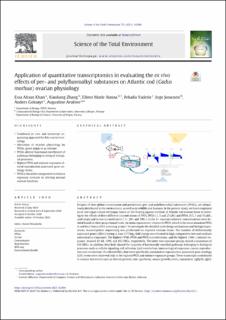| dc.description.abstract | Because of their global consumption and persistence, per- and polyfluoroalkyl substances (PFASs), are ubiquitously distributed in the environment, as well as in wildlife and humans. In the present study, we have employed an ex vivo organ culture technique, based on the floating agarose method, of Atlantic cod ovarian tissue to investigate the effects of three different concentrations of PFOS, PFOA (1, 5 and 25 μM) and PFNA (0.5, 5 and 50 μM), used singly and in also in combination (1×, 20× and 100×). In the 1× exposure mixture, concentrations were decided based on their proportional levels (in molar equivalents) relative to PFOS, which is the most abundant PFAS in cod liver from a 2013 screening project. To investigate the detailed underlying mechanisms and biological processes, transcriptome sequencing was performed on exposed ovarian tissue. The number of differentially expressed genes (DEGs) having at least 0.75 log2-fold change was elevated in high, compared to low and medium concentration exposures. The highest PFNA, PFOA and PFOS concentrations, and the highest (100×) mixture exposure, showed 40, 68, 1295, and 802 DEGs, respectively. The latter two exposure groups shared a maximum of 438 DEGs. In addition, they both shared the majority of functionally enriched pathways belonging to biological processes such as cellular signaling, cell adhesion, lipid metabolism, immunological responses, cancer, reproduction and metabolism. Shortlisted DEGs that were specifically annotated to reproduction associated gene ontology (GO) terms were observed only in the highest PFOS and mixture exposure groups. These transcripts contributed to ovarian key events such as steroidogenesis (star, cyp19a1a), oocyte growth (amh), maturation (igfbp5b, tgfβ2, tgfβ3), and ovulation (pgr, mmp2). Contrary to other PFAS congeners, the highest PFOS concentration showed almost similar transcript expression patterns compared to the highest mixture exposure group. This indicates that PFOS is the active component of the mixture that significantly altered the normal functioning of female gonads, and possibly leading to serious reproductive consequences in teleosts. | en_US |

